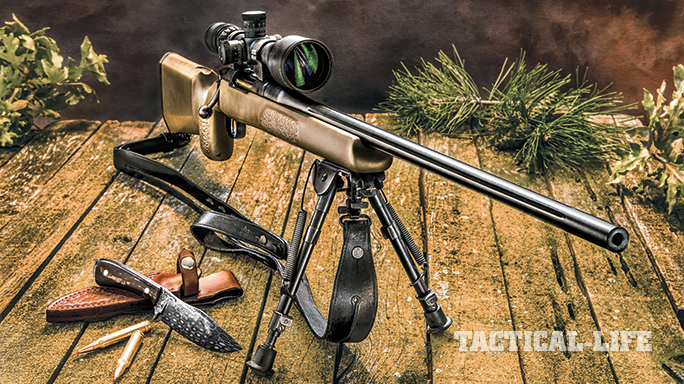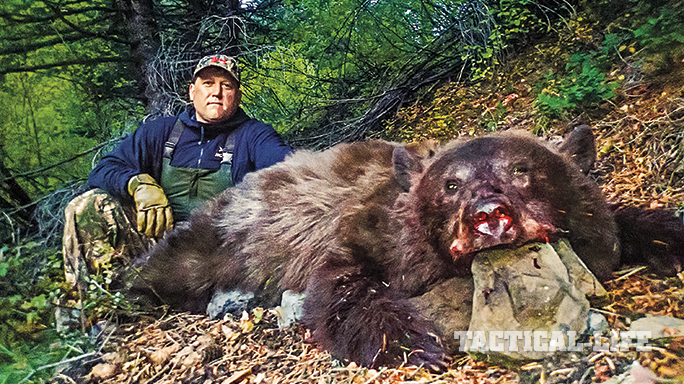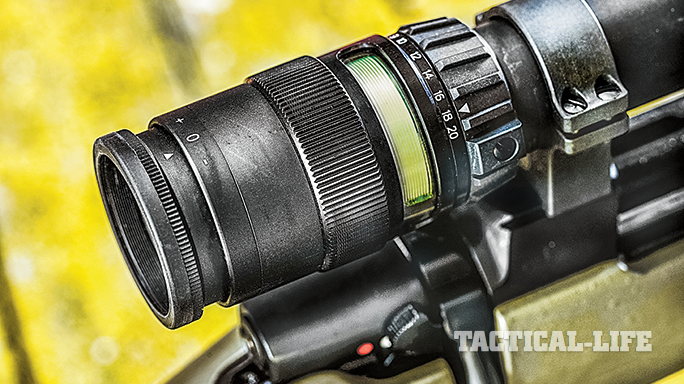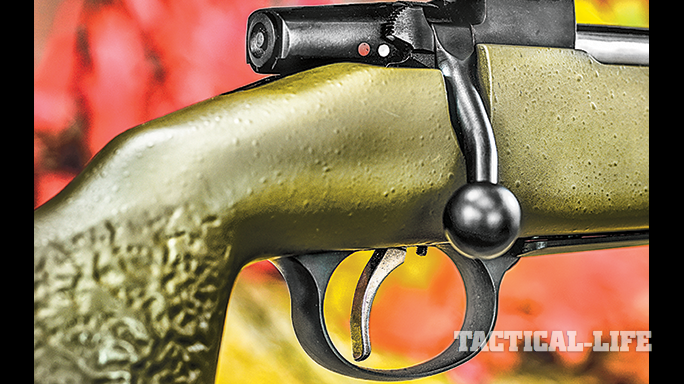If it weren’t for the feeling of a massive boot crushing your lungs, you might notice the weight of your pack, or your swollen feet, or the wind and sleet trying to push you backwards off the mountainside. What you have to sleep inside, change into, feed yourself, shelter your body with and, if you are lucky, take a shot at a pre-hibernation bear, is on your back. There is no road to “meet the truck,” no lodge with club chairs and cocktails, and zero climate control. Your hunting success or failure depends as much on your ability to operate in the terrain as does your ability to shoot or glass. Backcountry hunting is not for the faint of heart or weak of hamstring, but the payoff can be immense, and few experiences are more rewarding.
- RELATED STORY: CZ’s 9×19 75B Is the Company’s Modern Flagship
Reserved for those areas that are road-less or particularly remote, backcountry hunting is typically carried out on foot or as part of a mule or horse pack train. For some, it’s the higher calling and the only true test for a hunter willing to pit himself against an austere environment to find trophy game. One such hunter, Luke Carrick, of Yakima, Washington, agreed to take me into the Umatilla National Wilderness Area in Washington’s Blue Mountains for a backcountry bear hunt that proved to be both an education and a test of my physical limits.
Choosing to hunt a bear is no small decision. Even a black bear, under primitive circumstances, is higher on the food chain than a human. They are surprisingly fast and tough omnivores equipped with claws, large teeth and extraordinary strength. A backcountry bear hunt means going to their home—no dogs, no bait and no treestands. The selection of a rifle for a bear hunt involves the need for power and accuracy, and in the backcountry of Washington, the ability to shoot through the wind and between terrain features. A poorly placed shot or one from an underpowered rifle means a trek into unfamiliar terrain after a wounded bear that is both ticked off and at home. For my hunt, I chose a CZ 550 Sonoran rifle chambered in .300 Win Mag.
Advertisement — Continue Reading Below
Designed in part by professional shooter Tom Mack, the Sonoran is a precision hunting rifle engineered, in Mack’s words, “For the shooter comfortable taking a 400- to 800-yard shot and has to put the bullet in the right place the first time.” Built on the classic CZ controlled-feed 550 action, the larger-bore Sonoran rifle features a 26-inch, No. 4 contour, fluted barrel. Unlike other versions of the 550, the Sonoran rifle is aluminum pillar bedded and glassed into a 26-ounce, 100-percent carbon-fiber Manners stock. Though not a tactical stock, the Sonoran rifle is designed to be used with a scope. As such, the stock has an elevated comb to ensure a proper cheekweld appropriate to a scope, not iron sights. Further, the stock is built with a wider forearm to provide a stable shooting platform and a rigid support beneath the barrel. Mack adds, “This rifle is designed to be rugged and accurate. What we retained in terms of weight by adding the precision barrel we make up for with the carbon-fiber stock.”
The Sonoran rifle also features a full QPQ nitride finish, inside and out. This finish is designed to both protect the rifle from the elements as well as increase the barrel life. “The nitride finish takes the Rockwell hardness of the barrel to 72, making the steel extremely hard and extending the barrel life by two to three times. Additionally, it makes the rifle as weatherproof as possible and resists dings and scratches.” Weighing in at just under 8 pounds, the Sonoran balances the accuracy of a precision rifle with the weight savings of a carbon-fiber stock. Also, while the action is machined in Europe, the Sonoran’s stock, finish and barrel assembly are completed in the U.S.
For an optic, I mounted a Trijicon AccuPoint 5-20x50mm scope with a mil-dot reticle and a red, 0.33-MOA, illuminated dot at the center of the crosshairs. The AccuPoint scope is a perfect match for the CZ. Its large turrets adjust windage and elevation to 0.25 MOA, and the aiming point is illuminated utilizing a dual system of tritium and fiber optics. Its 50mm objective lens operates well in low light, and its 13.6-inch overall length is powerful and proportional to the CZ’s mass. From the bench, the rifle grouped at just inside 0.75 MOA with Black Hills 165-grain GMX cartridges. I zeroed the rifle at 100 yards and noted both holdovers and elevation adjustments out to 500 yards.
Advertisement — Continue Reading Below
Getting There
After a flight to Pasco, Washington, and a drive through rolling farmland, we reached the base of the Blue Mountains. The Blue Mountains sit in the southeast corner of the state along the border with Oregon, and they are a volcanic uplift from the Columbia Basin. Travel and work commitments being what they are, we couldn’t get to the mountains until well after dark, so the hike in on the foot trail was by headlamp and trekking pole. Fifteen minutes into the hike, we hit the snowline, and the winds from a low-pressure system strained the towering spruce trees along the trail. It was my first taste of what it meant to trust a local. We could be going anywhere. It was dark, the trail was barely visible, the sky was overcast and obscured by clouds. But Luke knew the way and he steered us up the mountainside with the joy of a kid taking a new friend to his hideout in the woods.
I needed a few more breaks than Luke or the third member of our party, Caylen Wojcik, a former Marine scout sniper, but slow and steady got us to our camp in a clearing just above 6,000 feet. Arriving at camp just after midnight, we quickly unpacked and prepared for a few hours rest and the next day.
Advertisement — Continue Reading Below
The next morning brought more wind and an overcast sky. Our wet clothing from the night before was frozen around the drying lines and covered with a layer of sleet. For now we had to “embrace the suck” and get to our observation spots. Our camp was just below the crest of the mountain ridgeline, so we moved down and across the ridge to a finger that looked down and across the valley to the south and east. The hike in cut across loose scree, grasses and over deadfall. Luke set us up on the edge of a rock outcropping where we could glass across a gorge where several spurs along two valleys converged. Luke had scouted a mahogany-colored bear on a steep hillside across the valley on several previous trips to the area. But from this vantage point we had multiple views across several natural lines of drift.
As the day continued, so did the marginal weather. The sky remained overcast, and the wind ripped down the valleys. We took turns glassing and walking up the spur behind us to keep warm. Even hand-warmer packets were of little use. Nature was making us pay to be here. She wasn’t going to give up one of her own without exacting a toll just because we hiked up one of her mountains. Evidently, the bear had no desire to leave the warm comfort of wherever he went to bed. We saw no sign of him. We did see a few elk and glassed another bear 3,000 yards, two ridgelines and a two-day hike away. We were in the right area, but nothing was going to happen here today.
To The Edge And Back
Advertisement — Continue Reading Below
Day two began much like the first, but the weather was changing. The hike back up the mountain had rewarded me with another set of wet clothes; however, the tough lesson learned is to peel off as much as you can, despite the cold, and let the exercise of the hike warm you up. This approach feels like a 15-minute cold shower, but ultimately your body warms up and you end up drier at your destination. This lesson in mind, I began the hike down the mountain with only a long-sleeved merino wool base layer, gloves and a wool cap. My pants were a set of camouflage wind-resistant bibs that I never took off.
Shortly after noon, Luke suggested a move to a new location. We would still be able to see the hillside where he scouted the bear, but could also glass a new ridgeline and several spurs to the west. This was an afternoon for elk, as another small herd of cows and an alpha bull fed across the hillsides of this new valley. Luke called to the bull, who bugled back aggressively in spite of his harem. The afternoon moved along as we got to know each rock, shadow and downed tree of our respective sectors. No bear. But the sun was warm, and we were enjoying the afternoon and perhaps growing a bit complacent.
I had just taken some notes and observations after re-organizing my pack when Luke scrambled up the rock face like a badger. “The big boy’s out. Grab your rifle.” At that, the primal instincts kicked in, and we were a hunting party in pursuit. The problem was we had to get across 1,000 yards of mountainside quickly, without tumbling down the face or spooking the bear. Time, temperature and fatigue all vanished in the adrenaline surge. Luke took off like a shot, and I did my best to keep up.
Advertisement — Continue Reading Below
We arrived back at our original position, and the bear was flipping small boulders atop the nearly vertical hillside. Thorough in his preparation, Luke had two shooting positions in mind with general yardage to where he had scouted the bear. As stealthily as possible, though it probably appeared like a controlled slide, we moved down our hillside with our eyes on the bear across the deep gorge. Arriving at the first possible shooting position, Luke turned to me and said, “518, what do you think?” I took one look through the scope and, despite my excitement, replied. “Let’s get closer. He’s in the open.”
The second position was 377 yards. This was going to have to be the spot. The terrain below us was nearly vertical, and the bear was moving up and away. I had mounted a Harris bipod on my rifle and, at the time, wondered if it had been worth the extra weight. It was—the terrain was so steep I had one leg of the bipod fully compressed and the other fully extended. I was lying on a rocky hillside in an odd but stable position. Until this moment, it had been all Luke—the location selection, the scouting and the strategy. I had one job to do besides keeping up: Make this shot. No time to turn turrets, I applied a 400-yard holdover and broke the first shot. The bear immediately went to his belly, and his head dropped to the rocky ground. I continued to watch him through the scope. He wasn’t moving, and I felt like I had broken the shot cleanly. I was hyper-focused, but Luke and Caylen were smiling from ear to ear and slapping me on the back. “Wow, great shot.” One of them said. Then the bear got up. I continued to watch him. Luke said, “Take a follow-up shot.” I fired again as the bear turned and put a shot through his neck. The next follow-up shot missed just over his back. The bear went back to his belly and slid down the mountainside and off a small cliff, where he landed heavily and didn’t move again. Which was good, because in my haste and excitement to run from one ridge to the other, I had left my spare ammo lying on my rucksack. Lesson learned: Keep your spare ammo on your rifle or person.
I kept my eyes on the bear as Luke and Caylen returned to our packs to get meat bags and knives. Less than a minute after they left, gravity overcame the lifeless bear and he began to barrel roll down the mountainside. Like a fur-covered avalanche, he continued to gain speed until he rolled off yet another cliff and dropped down into a steep gorge below. Out of my field of vision, I saw the tops of the trees shake as the bear continued to roll through the brush. Upon their return, Luke and Caylen approached me, “Len, where’s the bear?” I replied, “The good news is, he’s still dead. The bad news is, he’s down there.”
Advertisement — Continue Reading Below
Finishing The Job
To complicate matters, the sun was setting quickly, so we had little time to climb down the gorge and reach the bear. Near the bottom of the gorge, and nearly 200 yards into the steep but thick underbrush, the bear’s roll had stopped on a fallen log. With light only for a few quick photos, we admired his size (somewhere south of 400 pounds) and dark mahogany color of his heavy, pre-hibernation hide. With headlamps and the help of some boulders and rocks, we managed to create a ledge where we could work on the bear. Upon closer inspection, the first shot from the 165-grain Black Hills/Hornady GMX round had gone straight through the bear’s heart. The follow-up shot, though unnecessary, had gone through the bear’s neck and part of his skull. Shots that would have instantly folded a deer gave testament to the bear’s resilience and toughness.
Skinned, quartered and boned, we finished the job and packed the meat into cheesecloth bags. Watching Luke and Caylen, both experienced skinners, work practically in the dark was awe-inspiring. In what seemed like less than an hour, the meat and hide were packed and ready to move. However, the real jackpot was in front of us. It was now dark, very cold, and we were in a gorge 1,000 vertical feet below our camp. Luke’s familiarity with the terrain and the area navigated us out of the gorge and back up the mountain. This was the toughest physical challenge I had faced since my active-duty days in the Army infantry. In the dark, the mountainside seemed to go on forever, and my trekking poles were as much a safely device as an aid to my rubber legs.
Advertisement — Continue Reading Below
Shortly after 1 a.m. we drug ourselves back into camp and built a campfire. As much as I wanted to crack open a flask I had brought in anticipation of a toast to the bear, I decided some hot tea was a better idea.
- RELATED STORY: CZ’s First USA-Made Pistol: The CZ 1911 A1
This was been a hunt of a lifetime. Not just because it was successful, but because I was part of a team of hunters that trekked with minimal equipment into a rugged environment to honorably bring out a beautiful bear. And though I will have meat to cook and a warm hide for future cold nights, nature forced me to answer tough questions about myself and my values before she gave me her reward.
For more information, visit cz-usa.com or call 800-955-4486.
Advertisement — Continue Reading Below
- Caliber: .300 Win Mag
- Barrel: 26 inches
- OA Length: 46.8 inches
- Weight: 7.8 pounds (empty)
- Stock: Manners carbon fiber
- Sights: None
- Action: Bolt
- Finish: Nitride, matte black
- Capacity: 3+1
- MSRP: $3,199
This article was published in the 2015 Gun Buyer’s Guide. To subscribe, please visit PersonalDefenseWorld.com/subscribe.



























